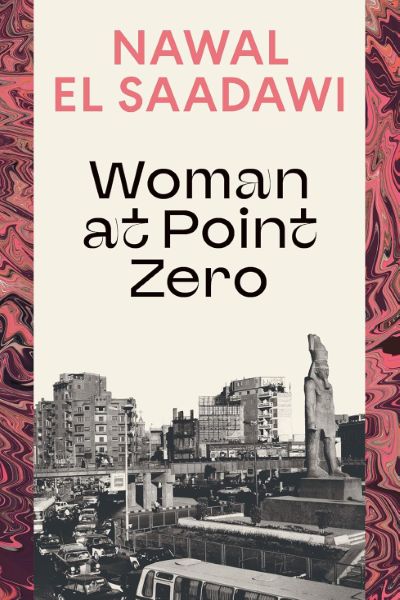Woman at Point Zero
A groundbreaking novel by Egyptian feminist pioneer Saadawi that exposes the violence and oppression faced by women in Arab society through the story of a woman sentenced to death.

📝 Book Review
“Woman at Point Zero” is a groundbreaking work published in 1975 by Egyptian psychiatrist and feminist writer Nawal El Saadawi. With its shattering power and unparalleled authenticity, this novel stands as a milestone in Arab feminist literature. Based on Saadawi’s encounter with a female prisoner while working as a psychiatrist at Cairo Women’s Prison, the work gives powerful voice through literary form to those women forgotten and marginalized by society.
The novel’s background is rooted in profound real-world foundations. Saadawi adapted the true story of a woman she met while working as a doctor at Cairo Women’s Prison—a woman about to be executed whose tragic experience serves not merely as personal misfortune but as a microcosm of the predicament faced by countless women in Arab society. Set in mid-20th century Egypt during an era of rapid social transformation, despite changing external political and social circumstances, traditional patriarchal structures remained as solid as iron walls, continuing to crush women’s living space.
The novel’s protagonist, Firdaus, experiences systematic violence from childhood that forms the foundation of her tragic life. Her childhood was filled with trauma—not only enduring domestic violence but suffering sexual abuse, these early traumas setting painful precedents for her later life path. When forced to marry a husband much older than herself, marriage became not a safe harbor but another prison, stripping away her freedom and dignity. Throughout various jobs in society, she continuously suffered economic exploitation, squeezed and used by those wielding power. Most cruelly, she was persistently used and abused by men, becoming their tool for venting desires and displaying power.
However, through these suffering experiences, Firdaus gradually awakens, beginning to recognize social injustice and the fundamental causes of her circumstances. Her awakening process is painful yet profound: first, she begins recognizing the relationship between money and freedom, realizing economic independence’s importance for women’s liberation; second, she starts fighting for sexual autonomy, refusing to continue being defined and controlled by men; in desperation, she ultimately chooses violent resistance, using the most extreme means to combat the system oppressing her; most importantly, even facing death’s threat, she insists on maintaining her dignity, unwilling to compromise with unjust systems.
Literary Mastery and Narrative Innovation
Saadawi demonstrates supreme literary skill in her technical craft. She employs first-person narrative structure, allowing Firdaus to directly tell her story to readers. This narrative approach greatly enhances the work’s authenticity and emotional impact, enabling readers to directly feel the protagonist’s inner pain and struggle. The “point zero” imagery carries powerful symbolic significance—it not only symbolizes the boundary between life and death but represents women’s marginal position in patriarchal society, pushed to society’s very edges, positioned at the critical point between survival and destruction.
Saadawi employs realistic descriptive techniques, revealing the true circumstances of women in Arab society through meticulously detailed observations that prevent readers from avoiding these cruel realities. The narrative structure creates intimate connection between reader and protagonist while maintaining critical distance necessary for social analysis.
The innovative use of confession-style storytelling transforms personal testimony into universal political statement, demonstrating how individual trauma reflects systemic oppression.
Anatomy of Patriarchal Violence
Through thematic analysis, the novel profoundly exposes multiple forms of patriarchal violence. Physical violence manifests as direct harm and destruction of women’s bodies; psychological violence operates through mental control and humiliation to destroy women’s self-respect and confidence; economic violence appears in systematic deprivation of women’s economic autonomy, making them completely dependent on men; sexual violence completely objectifies women as tools for satisfying male desires. These different forms of violence interweave to form a complete system of oppression.
The novel reveals how these various forms of violence operate not as isolated incidents but as interconnected mechanisms of social control that maintain women’s subordination across all spheres of life.
Saadawi’s analysis demonstrates how violence becomes normalized through cultural, religious, and legal institutions that frame women’s oppression as natural and inevitable rather than as systematic injustice requiring resistance.
Consciousness and Awakening
Firdaus’s growth process vividly demonstrates the complex journey of women’s consciousness awakening. She develops from initial compliance to questioning traditional roles, marking the emergence of critical consciousness; she moves from complete dependence on men toward pursuing economic and spiritual independence, embodying the awakening of autonomous consciousness; she progresses from forced silence to brave voice, showing the formation of resistant consciousness; ultimately, she transforms from passive victim to active resistor, choosing her own way to combat unjust systems.
The awakening process illustrates how oppression creates its own contradictions, generating consciousness that challenges the very systems designed to maintain women’s subordination.
Each stage of development reveals different aspects of feminist consciousness while demonstrating the psychological costs and practical challenges of resisting entrenched patriarchal structures.
Comprehensive Social Critique
The work provides profound and comprehensive critique of multiple layers of Arab society. It exposes how religion is exploited by patriarchy as a tool for oppressing women, critiques how economic systems systematically exclude women from power, points out legal system injustices and discrimination against women, while deeply analyzing how cultural prejudices maintain gender inequality with deep-rooted persistence in society.
The critique extends beyond specific institutions to examine how patriarchal ideology permeates all aspects of social organization, creating seamless systems of control that position women’s oppression as both natural and necessary.
Saadawi’s analysis reveals how different forms of institutional power collaborate to maintain women’s subordination while obscuring the political nature of gender relations through claims about tradition, religion, and natural difference.
Global Impact and Feminist Legacy
“Woman at Point Zero” has had profound and lasting international influence. Translated into multiple languages and distributed globally, the work became an important addition to the world feminist literature treasury. It provides valuable literary text for postcolonial feminist theory, helping people understand how colonialism and patriarchy interact in non-Western societies. The literary world recognizes it as one of the most important Arab feminist novels of the 20th century, its influence extending far beyond literature itself.
The work’s global reception demonstrates literature’s capacity to transcend cultural boundaries while maintaining specificity about local conditions and experiences of oppression.
International recognition of the novel helped establish Arab women’s voices within global feminist discourse while challenging Western-centric perspectives on women’s liberation movements.
Contemporary Relevance and Ongoing Significance
In terms of contemporary meaning, this work displays surprising continuing relevance. Despite being written decades ago, the violence and oppression faced by women described in the book still exist in many places throughout today’s world. It provides a foundation for dialogue and mutual understanding among women from different cultural backgrounds, promoting cross-cultural feminist exchange. More importantly, this work continues inspiring countless women to struggle for freedom and dignity, becoming an important spiritual resource for women’s liberation movements.
The novel’s analysis of how economic dependency, cultural control, and physical violence intersect to maintain women’s oppression remains highly relevant to contemporary discussions of gender inequality worldwide.
Current movements addressing domestic violence, economic justice, and women’s bodily autonomy find theoretical and emotional grounding in Saadawi’s unflinching analysis of patriarchal power.
Intersectional Analysis
“Woman at Point Zero” provides sophisticated analysis of how multiple forms of oppression intersect in women’s lives. Firdaus experiences violence not only as a woman but as a poor woman in a society where class, gender, and economic vulnerability compound to create particular forms of exploitation and abuse.
The novel demonstrates how patriarchal systems exploit women’s economic dependency to maintain control while using cultural and religious justifications to legitimize this exploitation as natural or divinely ordained.
Saadawi’s intersectional approach anticipates later theoretical developments in feminist thought while grounding abstract concepts in the lived reality of women’s daily struggle for survival and dignity.
Cultural Specificity and Universal Themes
While deeply rooted in Egyptian and Arab cultural contexts, the novel addresses universal themes of women’s struggle against patriarchal oppression. Saadawi’s careful attention to cultural specificity prevents Western readers from appropriating the text while demonstrating shared patterns of gender-based violence across different societies.
The work challenges both orientalist stereotypes about Arab women and universal feminist assumptions that ignore cultural difference, creating space for cross-cultural solidarity based on recognition rather than erasure of difference.
This balance between cultural specificity and universal resonance has made the novel valuable for comparative feminist analysis while respecting the particularity of Arab women’s experiences.
Medical and Psychiatric Dimensions
Drawing on her background as a psychiatrist, Saadawi provides nuanced analysis of how women’s resistance to oppression is pathologized through medical and psychiatric discourse. Firdaus’s responses to trauma and violence are presented not as symptoms of mental illness but as rational reactions to irrational social conditions.
The novel critiques how medical authority collaborates with patriarchal power to control women’s bodies and minds, defining resistance as madness while treating compliance as mental health.
This psychiatric dimension of the novel contributes to broader feminist critiques of medical authority while providing specific analysis of how mental health discourse serves to maintain gender inequality.
Economic Independence and Sexual Autonomy
Central to Firdaus’s awakening is her recognition of connections between economic independence and sexual autonomy. The novel traces how women’s economic dependency creates vulnerability to sexual exploitation while demonstrating how economic freedom enables greater control over sexual choices.
Saadawi’s analysis reveals how capitalism and patriarchy intersect to create specific forms of women’s oppression while suggesting that economic justice represents crucial dimension of women’s liberation.
The connection between economic and sexual autonomy provides foundation for understanding how different aspects of women’s liberation interconnect and mutually reinforce each other.
Language and Silence
Throughout the novel, Saadawi explores themes of voice and silence, revealing how patriarchal power operates through controlling women’s capacity for self-expression. Firdaus’s journey includes learning to speak her own truth despite social pressure to remain silent about experiences of violence and abuse.
The novel demonstrates how breaking silence represents both personal healing and political resistance, with individual testimony becoming collective challenge to systems of oppression.
Language emerges as site of struggle where dominant narratives about women’s nature and proper roles are challenged through alternative accounts of women’s experiences and aspirations.
Death and Dignity
The novel’s title and central imagery focus on the “point zero” between life and death where Firdaus makes her final stand for dignity and autonomy. Her choice to face execution rather than compromise her principles represents ultimate assertion of agency within constrained circumstances.
Saadawi presents death not as defeat but as final form of resistance available to those completely stripped of other options, challenging readers to consider what dignity means under conditions of total oppression.
The dignity maintained in extremis becomes powerful testimony to human capacity for resistance even under the most brutal conditions of dehumanization and control.
Educational and Activist Applications
“Woman at Point Zero” serves as powerful educational tool for understanding gender-based violence, economic justice, and cultural dimensions of feminist struggle. The novel’s combination of personal narrative and social analysis makes complex political issues accessible to diverse audiences.
Activist organizations worldwide have used the text to raise awareness about violence against women while building solidarity across cultural boundaries through shared recognition of patriarchal oppression patterns.
The work’s educational value extends beyond feminist contexts to broader discussions of human rights, social justice, and cultural understanding in multicultural societies.
Conclusion: Bearing Witness to Survival and Resistance
“Woman at Point Zero” stands as powerful testimony to both the brutality of patriarchal oppression and the resilience of human dignity under extreme conditions. Through Firdaus’s story, Saadawi creates lasting monument to all women whose voices have been silenced by violence while demonstrating literature’s capacity to bear witness to suffering and survival.
The novel’s enduring significance lies in its refusal to sentimentalize either oppression or resistance, presenting instead clear-eyed analysis of how power operates while honoring the courage of those who resist despite overwhelming odds. Saadawi’s achievement transcends literary accomplishment to become crucial contribution to global understanding of gender, culture, and justice.
By placing one woman’s story at the center of broader analysis of social systems, “Woman at Point Zero” demonstrates how individual testimony can illuminate collective conditions while transforming personal pain into political understanding. The work remains essential reading for anyone seeking to understand how patriarchal violence operates across cultures while maintaining hope for transformation through consciousness, solidarity, and resistance.
The “point zero” of the title ultimately represents not only the moment between life and death but the point at which traditional assumptions about women’s nature and destiny can be challenged and transformed. In reaching this zero point, Firdaus—and through her, countless other women—claims space for alternative possibilities based on dignity, autonomy, and justice rather than submission, dependency, and silence.
Discussion
读书讨论
分享您对这本书的感想和看法,与其他读者交流见解
加入讨论
分享您对这本书的感想和看法,与其他读者交流见解
加载评论中...
Book Info
Related Topics
🛒 Get This Book
 Buy on Amazon
Buy on Amazon Related Books
读书讨论
分享您对这本书的感想和看法,与其他读者交流见解
加入讨论
分享您对这本书的感想和看法,与其他读者交流见解
加载评论中...

